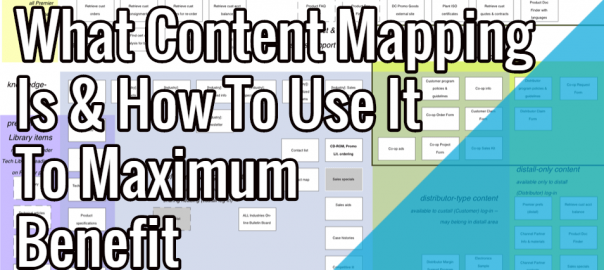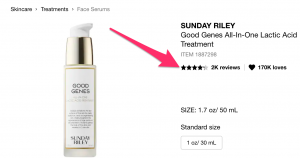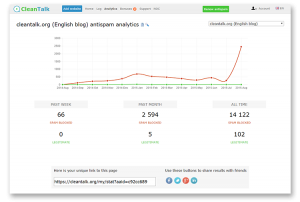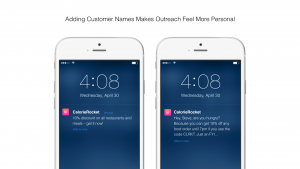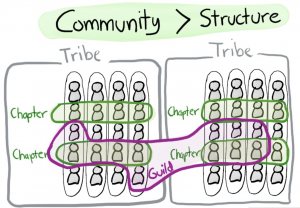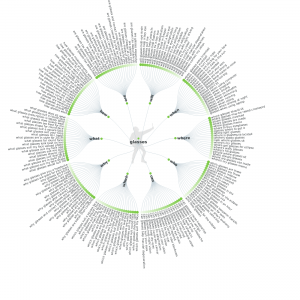September 1st, 2015

Do you know people who talk and talk and you cannot get a word in edgewise? Of course, you do. When those people talk at you, do you drift away thinking about something else and then float back into the conversation only to realize that the person is still talking? Do you think, “Why am I still listening?”
Don’t let your site to be like that person. In real life people rarely walk away from such talker in the middle of their sentence. We are polite, usually. On the internet, staying and listening is not necessary. Your visitors will leave while your site is still talking.
The good news is content mapping helps you talk to your visitors and not at them .
What Is Content Mapping And Why Should I Do It?
I like Hubspot’s definition of content mapping as a “process of delivering the right content, to the right people, at the right time.” (Source). Know your customer and what they are looking for, and you will know what content to show to the right people and when. Know how your visitors make decisions, and you will be able to help them along the way by offering just the right information. Your website visitors are on a quest. Are you there to help or stifle their efforts? Will you make them victorious or annoy them by presenting irrelevant or out of step content? It is up to you.
It is very important to match your content to intent. If the visitor is just getting to know your company and its offerings, it is premature to ask them to buy. They will not only get annoyed, but most likely will lose their trust in your company. On the other hand, if the visitor is ready to buy but cannot, because there is no end to the list of benefits and testimonials, the visitor will take their money to a competitor who has a readily available “buy now” button.
Content mapping will help you align your digital marketing with your customers’ on your website. Become your visitors’ best friend and a trusted advisor by listening to them. Understand how they make decisions, how they buy, what is important to them and craft your offer that appeals to your audience. Separate them into different groups and talk to each with a message that resonates with them. Connect your buying cycle with their purchasing habits and create digital harmony that you can take all the way to the bank.
How Do I Map My Content?
All you need is to understand your customer and their journey, how they make decisions, what type of content they respond to, as well as their searching intent. Add this knowledge to your buying cycle and you will start on the road of mapping your website content to delight your website visitors.
Creating buyer personas is the first step in content mapping process. Personas are representations of your customers. Ideally, you divide your customers into groups and create personas representing each group. Every persona you create will have a name, gender, age, personality, a problem they are trying to solve, and how they prefer to solve it. Add to the persona description what makes your product so attractive to them and why they should choose your company over competition.
Describe their personality and preferences. Do they want to look better than others? Do they want to feel they have done their research when picking a solution? Do they want to achieve results quickly? Do they care about proof? Are they looking for approval from their friends or colleagues?
How will you help them fulfill their wish?
Bryan Eisenberg is one of the main authorities on personas. You can create your own persona by following Bryan’s advice. Get his book Buyer Legends and dig deeper into the subject. You cannot go wrong by trying to understand your customers as much as possible.
Take your persona creation skills to a new level with psychographic targeting. The absolute expert on this topic, Marty Weintraub, has been generously sharing his cutting edge psychographic pro tips in presentations and blog posts. He suggests to utilize websites like Facebook, YouTube, LinkedIn, etc., that employ tagging and tracking. Give your persona a personality by analyzing the data available for advertisers on these channels. For example, learn that a frequent traveler also prefers reading mystery books. Use this knowledge to pick distribution channels for your content.
Content comes in different flavors. There are many content types: blog post, infographic, webinar, video, survey, case study, white paper, etc. Picking content type that is attractive to your audience at a specific step will help you connect with visitors and send them off to continue the journey.
Once you understand your customers, you usually know where they hang out. Pick your content distribution channels based on social channels your audience frequents. When you are promoting your content on social channels, most likely you will be creating awareness, thus contributing to the top of your sales funnel.
Become a master at creating awareness – it is your ticket to a successful website. “I am not my stock price,” said Jeff Bezos, reminding us not to focus only on outcomes. Bring in quality traffic, perfect audience, and do not worry about conversions as much. Once you tailored your content to the prospects that might not know much about your company and offered them compelling information, they will take you seriously.
Consideration is the next step in the buying funnel. You are in the game. You are one of the finalists. You could be The Winner. To become chosen, you need some powerful persuasion skills. Luckily, you know how your persona makes decisions. Use this information to craft just the right message that will move them to purchase. Articulate exactly what they need to know (and they usually do not) about why you are the clear choice for them.
When they are ready to buy, please, please just let them. Stop with the benefits, stop with the testimonials, stop with convincing. Just give them a button to press. They are ready. Get out of the way.
Advanced marketers would also consider customer journey through the website from entry to purchase. Review analytics. Learn from surveys and feedback. Understand, what makes your content interesting and engaging to your customer.
The process does not stop with a conversion. We cannot forget customer nurturing stage where we send out emails with carefully selected content to solidify our relationship with customers. The content aims to reach the customers represented by personas, to assure them that they made the right choice by doing business with you.
Remember that people consume content differently. Use your persona description, content sentiment, visitors’ intent to make the next click very appealing to your potential customers.
Here Are The Steps To Map Your Content
- List topics, themes, and industries relevant to your company.
- Conduct competitive analysis and understand how you stack against your competition in your industry topics.
- Define personas.
- Audit content and tag by topic, content type, sales cycle step, and persona.
- Optimize existing pages.
- Create a plan to fill content gaps.
- Implement your plan.
Conclusion
Content mapping makes your site about your customer, not about your company. Once that happens, your customers will start trusting your company because you make it about them – their needs and their questions; you understand and solve their problems. In return, they will give you their support, trust, and their business.
It is your choice to do or not to do content mapping. You can continue talking at your customers, shouting about your company on social media and making your website about you. Or, you can start listening, making your website about your visitors, converting them into customers.
Your content. Your business. Your choice.
What Content Mapping Is & How To Use It To Maximum Benefit
The post What Content Mapping Is & How To Use It To Maximum Benefit appeared first on Search Engine People Blog.
(165)
